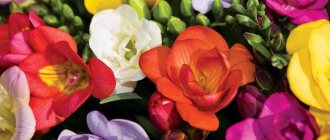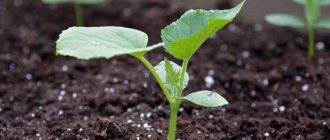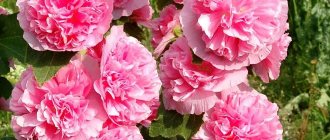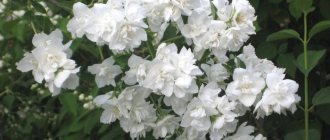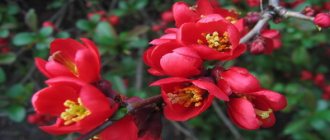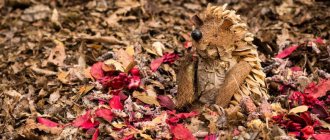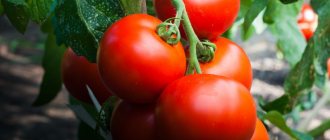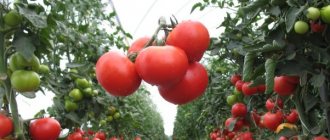Knotweed is a perennial shrub-type plant belonging to the buckwheat family and is a separate species, consisting of more than two hundred subspecies and varieties. Of all this wonderful diversity, about twenty of its varieties and hybrids are cultivated.
Author of the article
Maxim Sverchkov
Professional biologist and breeder with extensive experience and experience.
In Greek, its name means polygonal figure. The place of origin of the plant is considered to be the region of the Far East and the islands of Japan and the Kuril ridge. Currently, it is cultivated and grows wild almost everywhere, on all continents of the Northern Hemisphere.
Description of the plant
The plant is a shrub of varying heights, reaching at maturity, depending on the plant variety, from thirty centimeters to four meters in height.
In tall shrubs, from a powerful root system, curly branches grow vertically, on which there are large but sparse leaves. These shoots form a highly branched crown, very thick and dense. The knotweed has a stem of a very peculiar shape, reminiscent of bamboo in appearance.
During the growing season, the plant blooms with flowers with small petals that have different shades of red - from light pink to dark cherry. These flowers are collected in small panicle-shaped inflorescences.
In some mountaineers (a subspecies of buckwheat), the shoots spread horizontally, extending fifteen meters from the central part of the plant. These plants are characterized by thinner branches, reduced leaf size and inflorescences that differ in shape from other types of shrubs, uniting up to a dozen flowers.
As soon as the plant blooms, small grains of seeds are formed in place of the flowers, placed in a nut-like fruit. After it ripens, the fruit bursts and the seeds spill onto the ground, germinate and emerge, forming new young knotweed shrubs.
The green, dark leaves growing on the branches of the plant have a loose, delicate structure, although in appearance they seem elastic and dense. They are a valuable raw material for the preparation of traditional medicines and are eaten raw, as they contain many minerals and vitamins beneficial to humans.
Young shoots of certain plant varieties are also used in cooking.
Knotweed is also used as an excellent honey plant, from which bees collect excellent honey, the so-called buckwheat.
One cannot fail to note the decorative use of shrubs. Its climbing varieties are quite suitable for using it as a green covering for walls and verandas of buildings, fences, etc. In the garden, its climbing shoots are organically combined with various flowers and flowering shrubs.
PROBLEMS AND SOLUTIONS
Thin shoots at the top of the bush are broken - this can happen in very strong winds or rain. A squally wind can pretty much ruin the appearance of our giant. Agree, a plant with inflorescences hanging down does not look very neat. In this case, there is only one recipe - trimming the broken peduncles to the height of the break. Do not be afraid! The changeable mountaineer responds well to such a “haircut.” Even if you cut the entire bush at the peak of flowering to a meter in height, after three weeks it will bloom again.
Variable knotweed is not susceptible to diseases and pests.
Types of knotweed
In our country, highlander is represented by the following species.
Weiricha
Wild thickets of these shrubs are found in the mountainous areas of the Kuril Islands and Japan. When artificially propagated, a powerful plant with a branching crown is obtained, covering a large space. The root system of this species is superficial. Flowering occurs at the end of the summer period. White small flowers, shaped like a brush, cover the upper parts of the shoots, collecting in small inflorescences. The frost resistance of the plant is quite high. Feels great on poor, infertile soils.
Capitate
Small bushes, reaching only fifteen centimeters in height, are grown as annuals. Peak growth occurs at the end of spring. It has small green leaves covered with red stripes. The flowers are pink, collected in round inflorescences. Flowering begins in mid-summer and ends at the end of autumn. To grow it, you should choose places with good sunlight, since in the shade of other plants it loses its decorative effect. It is used for planting in boxes along the paths of the estate, and is also grown in pots at home.
Aubert
A small shrub with creeping shoots similar to vines. The oval-shaped foliage, painted an even green color, measures nine centimeters in diameter, turns red in the fall. Flowering begins in late summer and continues in autumn. For shoots, it is necessary to make supports to form a bush. Its leaves are eaten both raw and boiled. Not afraid of pests, almost never gets sick.
Kamchatka buckwheat
Tall, up to four meters in height, shrub with vertical branches covered with heart-shaped green leaves. During the growing season it is decorated with small white and very fragrant flowers, collected in large paniculate inflorescences. It is very resilient; when it is removed, the smallest roots remaining in the soil sprout. Suitable for large garden areas for shading plants that need it.
Related
A small shrub with thin shoots spreading along the ground and reaching six meters in length. The leaves are small, oval, even green in color. It begins to bloom in late spring, the growing season lasts until the last months of autumn. Crimson and white flowers, collected in large inflorescences, abundantly cover long curly shoots, emitting a strong, pleasant smell. It is used for decorative purposes and as an excellent honey plant.
Candle-shaped
A medium-sized bush, reaching two meters in height, the branches are straight and vertical. The leaves are green, oblong-oval, and do not change color with the arrival of autumn. Blooms in mid-September, flowering lasts until winter. The flowers are small, with crimson petals, collected in spike-shaped inflorescences. Frost-resistant, but requires covering with spruce branches in winter.
Sakhalin
A tall three-meter shrub with vertically growing tree-like stems covered with large, even green leaves. The flowers are white, very fragrant, collected in spike-shaped inflorescences. It is developing very quickly and growing at an accelerated pace. Suitable only for large garden areas due to its extreme durability.
Baljuan
A small perennial bush with creeping shoots resembling a vine, growing up to ten meters per season. The foliage is large and dense, painted an even green color. Flowering begins at the beginning of autumn and ends with the first frost. The flowers are white, collected in paniculate inflorescences. The plant requires strict control of the growth of shoots, which, if uncontrolled, cover the entire space around them for many tens of meters.
Agrotechnical features
To grow knotweed, it is important to have plenty of light. Sometimes it does well in semi-shaded areas, but may not bloom as profusely.
In order for the plant to produce beautiful buds for several years, you need to take into account several rules of care:
Thanks to its resistance, the plant is practically not susceptible to diseases and pests.
Serpentine breeding
There are three ways to propagate a plant - by seeds and cuttings, and root division. The seeds must first undergo stratification (temperature +5°C), this process must last at least 2 months, so they are sown before winter, and the first shoots are observed only after warming. When planted using the seed method, flowering will occur only after 2-3 years.
The division of the rhizome is carried out in the spring, the bush is dug up, divided into several parts so that each has “living” elements. Then the planting material is planted in different holes and sprinkled with soil.
Cuttings are also performed. To do this, prepare cuttings (it is best to do this in June); each shoot should have 2 nodes. The prepared units are treated with Kornevin, carrying out the procedure in the basement. The plant needs to be planted in warm soil; for this, a little horse manure, fertile soil, sand and peat (1:1) are added to the garden bed in advance. The lower node is buried 1.5 cm, and after planting it is covered with plastic film. For the winter, seedlings are dug up and stored until spring at a temperature of +2-3°C. In the spring they are planted in a permanent place.
Growing knotweed
The plant is not demanding on the composition and acidity of the soil, but it develops better in nutrient-rich and loose soils.
Landing
A plant such as knotweed is planted and grown by division, shoots, cuttings, and seeds.
Divide a strong adult plant into parts, handling the roots very carefully. Damage to them can greatly affect the development of newly planted knotweed. After planting the divided part, it is watered abundantly.
The shrub practically reproduces itself through shoots. Creeping shoots, having encountered fertile and moist soil along the path of their growth, can take root at the point of contact with the ground. After the formation of such a new bush, it is separated from the main plant and replanted.
To propagate by cuttings, take a thirty-centimeter part of a young strong shoot, plant it in the ground and water it. Roots appear in two weeks. After some time, leaves appear on the sprout.
Before sowing, seeds are stratified by placing them in a low-temperature environment for the winter. In early spring, they are placed in boxes filled with a fertile earthen mixture, covered with transparent material and placed in a place with an air temperature of at least twenty-five degrees Celsius.
As soon as the sprouts appear, they are brought into the light. After the leaves appear, the seedlings are divided into single pots, and after warming the soil to an acceptable temperature, they are placed in prepared holes, covered with soil rich in nutrients.
In another article we described: Nightshade.
Care does not require much work; mountaineers are not afraid of dirty air, drafts, direct sunlight, and are unpretentious to soils. But the plant develops best in places with good sunlight.
If the soil is not fertile enough, periodic feeding of the bush with organic fertilizers is required.
Watering
Watering young shoots should be done every day. To prevent excessive evaporation of moisture, the planting site must be mulched.
Trimming
For the winter period, despite the high frost resistance of the shrub, it is better to prepare it by cutting off all its above-ground parts as short as possible and covering them with spruce branches or other suitable material. If, despite this, the plant is damaged by frost, it will recover itself in a short time.
Transplantation must be carried out after ten years of growth of the knotweed in one place.
Reproduction methods
This variety cannot be grown from seed. Knotweed can be propagated using cuttings or root shoots. The use of any dilution method depends on the time of year. For example, in spring, before inflorescences form, flowers are most often propagated by shoots. Due to the fact that the roots of young shoots have not yet gained strength, this breeding method is the most effective.
This variety of highlander is so unpretentious that it can be propagated using cuttings. This method can only be used in summer during the flowering period. However, the cuttings must be prepared in a certain way and only then are they allowed to be replanted as an independent plant.
Beneficial features
Dried roots of knotweed are used as raw materials for the preparation of medicines that have an anti-inflammatory and hemostatic effect on the human body.
A tincture of powder prepared from the roots of the plant is used as a folk remedy for inflammation, diseases of the gastrointestinal tract, stones formed in the kidneys, and sore throat. For diarrhea, this powder is taken orally in dry form.
Recipes
Poultices made from fresh or dry steamed herbs soften and cleanse ulcers and relieve pain.
Sitz baths with a decoction are indicated for hemorrhoids and nervous diseases. They eliminate bleeding, relieve itching, and soothe. Crushed leaves can be applied to the back of the head as a mustard plaster if you have a runny nose or headache. For toothache, rinse juice is diluted in a ratio of 1:10. Recipes for internal use:
- Herbal decoction: for 250 ml of water you need to take 20 g of dry crushed raw materials. Boil for 15 minutes, leave for 45 minutes. Take 1 tablespoon 2-4 times/day.
- Root decoction: in 1 liter of water for 15 minutes. boil 20 g of raw material, strain and drink 50 ml 4 times a day.
- Alcohol tincture: 10-20 drops, frequency of administration – 2-4 times/day.
- Infusion of knotweed root: add 200 ml of boiling water to 10-20 g of raw material and leave overnight. Take 1 tablespoon 3-4 times/day. The infusion is effective for lotions, douching and rinsing.
- Bittersweet extract (concentrated decoction): drink 1 teaspoon 3 times a day.
